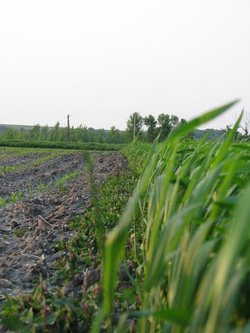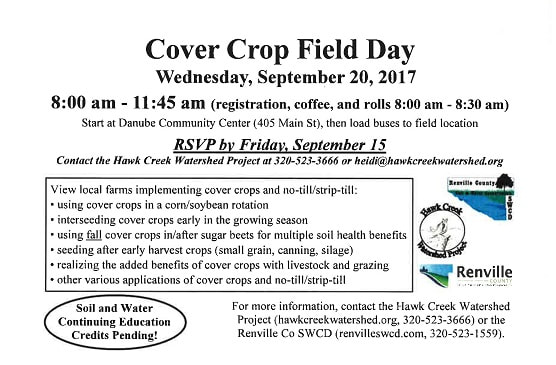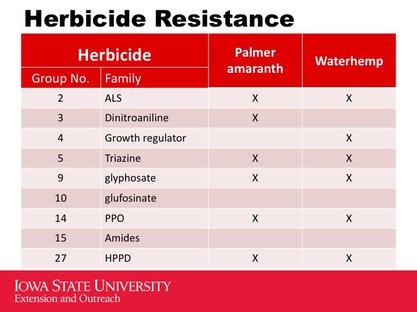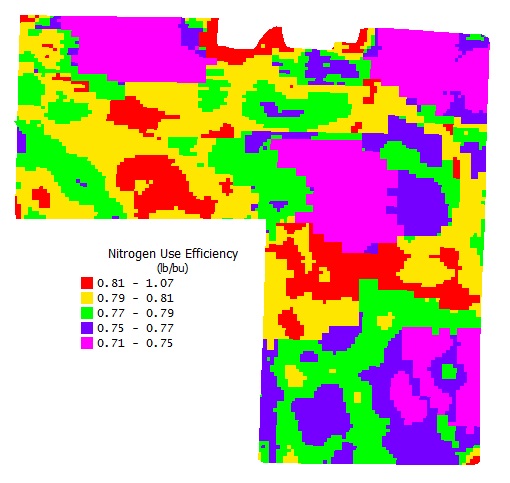|
You have most likely heard,You have most likely heard,
that the herbicide label for dicamba beans was EPA approved a short time ago. You have also heard my opinion on this technology but I knew it was destined to arrive. Since registration has only been recently approved, there has not been a lot of time to review the label for application instructions and no doubt the label we see today will not be the one you need to read next season, but there are some initial points of interest you should be aware of. Corn and Soybean Digest magazine (as well as others) recently published their own list of label considerations, which you can find here: http://cornandsoybeandigest.com/soybeans/12-considerations-make-when-it-comes-xtendimax-label, but I will just point out a few that I think deserve special mention.
As I previously mentioned, it is certain that this label will be amended before the next spray season and I know this winter it will be promoted as the savior of weed control. That is what bothers me. I know this technology is here, and we will soon see the 2,4-D version of it soon, I suppose, so my hope is that everyone will use these products wisely. The Liberty system has been doing well, but it is overused and this new technology is hitting the market when there is already resistance to it, as indicated in the ISU chart above, so if you do decide to try this product, here is my suggestion: use these products in rotation. If you use the dicamba product in beans then don't use any dicamba product in your corn this year or in next years corn. Switch to liberty on alternating years or every third year once the 2,4-D version is released. You cannot use the same technology all the time and if your seed adviser says you won't have any problems you need to do two things. First, think hard about whose interest he has in mind and, second, find a new seed adviser. I will publicly say it; it anyone tells you not to rotate to other technologies, they are a fool. Well, I want to end this on a positive note. I have just read about a new breakthrough in the control of soybean cyst nematode. It sounds like researchers at Kansas State University have found a way to mess with the genetics of SCN when they feed on soybean roots. This will be a game changer if they can get this to work.  Frost DamageI took advantage of some dry surface soil to get out with the ATV this weekend. In particular, I was interested in looking for what I hoped I wouldn't find. After two nights of cold temperatures, the effects of frost started showing up this afternoon. It will be another day or two before the full affects will be known but there are some areas with some fairly good sized spots showing now. As would be expected, the lower lying areas of fields are showing more severe symptoms but I don't think the higher spots of many fields were fully out of danger. The corn you see in the pictures will certainly survive, but the above ground tissue will certainly not survive. It also did not seem to matter if the plants were larger, with a couple of leaves, or just spiking out of the ground; all got hit. I have not seen any soybeans that have emerged, but have heard of some. They, as well as any newly seeded alfalfa and beets probably got a kicking in the last couple days and will need replanting. We can only wait to see. Another note - with the increased acres of conventional corn planted, there is an increased concern of the amount of European Corn Borer that may survive if we get any major ECB flights this year. To help track that I purchased some ECB pheromone traps and have one yet without a home. If you would like to have one at your place, let me know, and I will get it to you when the time to monitor them comes. My only requirement is that you look at it once every few days to help monitor ECB flights. Kooper and I were talking about staging crops for pesticide applications and such. He put a few words in about the importance of properly staging your crop: Crop Staging is very important when it comes to raising a successful crop. There are several reasons why it is important to properly stage the vegetative growth stages in your fields. When it comes to applying herbicide to your crops, it is a necessity to be able to properly stage your crops. Herbicide that is applied to early or too late, in accordance with the herbicide label, will more often than not result in a crop injury, which often results with decreased yields. For example, in the next several weeks, some people may be wanting to apply Status to your corn. If you apply your Status before V2 growth stage in corn, it is likely to see twisted whorls and buggy wiping in your plants. Ultimately reducing your potential yield for the season. Similarly, when applying fungicide at the wrong stage of the plants’ development, in some cases, the fungicide will have no effect on the plant. Meaning you are just throwing money out the window. For a successful 2016 farming season, be extra sure you are properly staging your fields this season. Here is a link to a recent nitrogen use efficiency newsletter article: http://us10.campaign-archive2.com/?u=c5592d5c1799bcbd9fd577df5&id=7e2dacc906&e=1fec15fdf4 Nitrogen Use EfficiencyNitrogen use efficiency (NUE) is a measurement to determine how many pounds of nitrogen has been used to produce one bushel of your harvested corn. It is actually a fairly simple calculation to do, you simply add up all of your nitrogen inputs and divide by yield. On a field composite basis your NUE equation may look something like this:
Soybean legume credit (25lbs) + soil test nitrogen value (25lbs) + applied nitrogen (150lbs) / yield (200) or 25+25+150/200=1 lb N/ bu. If your yield would have been 175bu/ac then the NUE in the above example would have been 1.14 or if yield was 225bu/ac then the NUE would be .88. we intuitively use this calculation every year when determining nitrogen fertilizer recommendations but we have never used this calculation to determine if management procedures should change. I think everyone can agree that having the lowest possible NUE is the desired outcome of a nitrogen program. Why is this calculation potentially valuable to you? One reason is that it can tell you two things: first, you can identify the locations in your fields where you are applying the least amount of N fertilizer and realizing highest relative yield and, secondly, and conversely, you can identify those areas where you are applying the most nitrogen fertilizer and realizing the lowest relative yield. At first, this may seem like a fairly simply concept, but if this calculation was done only with applied nitrogen you would get a false view of the field – what if you had variable soybean yield, hence, variable soybean nitrogen credit? What if you had variable soil residual nitrogen? I think a couple of the best uses of an analysis such as this is to evaluate yield and direct nitrogen applications to take the best advantage of the soil mineralization you may see. If you have a NUE of, let’s say, 1.3 or above we should maybe ask why. Was it because yields were low? If so, why was that. Was the same yield seen on a NUE of 1.3 as was on a NUE of .9? Why was that? Perhaps the nitrogen application plan was artificially high or the yield goal in that area not accurate. Another great use of this type of analysis is directing future sampling. I chose the above field as an example because this one illustrates perfectly how NUE and soil type correlate. In the above field the areas of most efficient NUE had about the same yield as the areas of less efficient NUE. A quick calculation shows that about .3 pounds of nitrogen less was needed to realize the same yield. On a 200 bu/ac yield that is approximately 60 pounds of nitrogen or approximately $30/ac. I think that is worth investigating. Why the difference in the NUE in those areas? It was because they were sampled separately for nitrogen and differing soil residual N was found and taken advantage of in the nitrogen application plan. An anomaly? I don’t think so. So far this spring I have gotten back a handful of spring nitrate tests and the results of those tests are below. There is a range of nitrogen values in your fields and we should be taking full advantage of them. 24 inch soil nitrate results - Spring 2016 68 33 41 56 64 29 81 40 76 15 34 47 128 68 57 29 156 32 21 73 36 33 61 71 30 38 40 58 33 42134 44 59 130 37 42 105 60 White mold and corn stalk rots:
Click, or copy and paste, the link below to see the latest newsletter or just sign up under the newsletter tab. http://us10.campaign-archive1.com/?u=c5592d5c1799bcbd9fd577df5&id=1bfa43d2a9&e=1fec15fdf4 Here is a couple of quick notes on field observations:
Bean fields are starting to show some weeds. Surprisingly, I am seeing more grass than in the past but generally it is the same list of weeds that is expected. The bean pre herbicides should start to peter out so this observation is not unexpected. Now that fields are drying and some spraying can go on, remember if you have not had the chance to spray for volunteer corn, the rate of whatever product you have been using will probably not be enough. Generally your vol. corn recommendation is for corn that is less than 12 inches tall and the rate needed to control corn above 12 inches is higher than what is normally talked about. Also, expect your vol corn product to work slower on this taller corn. Corn fields are for the most part, clean. Corn fields, as you have noticed, are not the right color. This is due to the excess rain, but not necessarily due to loss of N as corn will show symptoms similar to N loss in saturated soils. Here are a couple of good articles that discusses this: http://cornandsoybeandigest.com/fertilizer/estimate-nitrogen-losses-wet-corn-fields?NL=SO-09&Issue=SO-09_20140628_SO-09_749&[email protected]&YM_MID=1473471&sfvc4enews=42&cl=article_2_b and http://www.extension.iastate.edu/CropNews/2014/0617sawyer.htm. This week there needs to be some discussion on what can be salvaged from the corn fields in regards to supplemental N applications. Here are a few thoughts about using a cover crop on your acres that have been lost to flooding…
The crop that has been talked about most for use as a cover crop is turnips and/or radish. Both are good choices and have benefits like breaking up compacted soils, retrieving deep nutrients and after the tuber dies, it leaves a wonderful depression within the soil surface that facilitates water infiltration. One of the major drawbacks of these crops are that they are non mycorrhizal. A mycorrhiza is a symbiotic association between these natural soil fungi and many crop plants. This association helps the crop assimilate phosphorus and can be very important to crops like corn when phosphorus becomes less soluble – like in soils that are wet and cool. A bare soil, or one that has a crop that does not support mycorrhizal associations will have a greater chance of showing ‘fallow syndrome’ symptoms the follow planting season. Being non mycorrhizal is a big deal. For this reason, planting a turnip or radish cover crop by itself is probably not the best choice but a good choice as a base for a cover. This is my suggestions: use the turnip/radish crop a small grain such as oats. This will be one of your most economical choices and you get the advantage of having the turnip/radish as well as a crop that supports mycorrhizal associations. Adding a legume to the mix (if planting in lost bean acres) will give some recovery of the lost legume credit for your next corn crop. There are also mixes available that create a great deal of biomass that can be chopped or baled if needed for forage as well. A cover crop can be as simple as you need it to be; don’t get caught up in the idea that you mix needs to be some exotic blend of many different species. Just remember that if you are using a small grain or other patented protected crop that bin running the oats, wheat or other as use in the case could be violated the Plant Variety Protection laws. One of the suppliers I talked with today told me that if there is a place available, he will supply some seed to create a cover crop plot in order to get some local exposure to the cover crops. I would like to take advantage of a drowned out spot to do so if anyone is interested allowing so.  Now that it is getting close to that time a year again, I thought it may be appropriate to remind everyone to remember to not forget about soybean cyst nematode sampling. We have been pretty good in the past to address SCN and we got a good indication of how widespread they are and how heavy the infestations are in some fields. Since then, we have been (and probably OK in doing so) more lax on sampling for SCN. After a few years of management tactics, variety selection and rotations, I think it is time to focus on them again. Remember, up to 30% yield reduction can be realized before any visible SCN symptoms are seen in the field. This discussion cannot be fruitful unless you do something about them once infested in your fields. The best thing for SCN is rotation. Unfortunately, a two year bean rotation is not enough to fully manage SCN, so unless you are going to be planting corn on corn or an alfalfa stand, you need to rely on your soybeans to help in keeping SCN in check. As of now you have only two options for genetic SCN control; soybeans which have the PI88788 resistance and the soybeans with the Peking resistance. Unfortunately the vast majority (perhaps 97% or so) of the SCN resistant soybeans on the market have the PI 88788 resistance in them and this means of resistance is rapidly losing viability. There are not many, but some Peking soybeans are available and should be incorporated into your SCN control strategies. Do not, however, over use any of these methods. We’ve seen what happened to RR and CRW when used unimpeded. Plan your varieties carefully. A non SCN bean can still be your best choice. A good non SCN bean in the right field will often out do a SCN bean with the wrong genetics. You should be using all three beans. Rotate the PI88788 genetics with the Peking genetics but not every other year as you will still be only applying the one form of resistance to the field on a C-S rotation. Purposely include non SCN beans as this is the only way to keep the genetic resistance that you have working. Even though the Peking resistance has shown to be many times more effective at controlling SCN than the PI88788, it has been proven beyond doubt that exclusive use of the Peking resistance will cause it to fail within just a few seasons.  Here is another quick update on soybean aphids. So far, I have only found a handful of fields in which it is time to spray. The vast majority of soybeans have very low levels and those levels haven’t been increasing very fast. So far, there is no reason to panic, just keep monitoring them. We have a few weeks left before they are of no concern. If spraying does happen there are a few thoughts you should take into consideration when deciding which product to use. There are only two chemistries (chlorpyifos – the active ingredient in lorsban and generics, and bifenthrin – the active ingredient in capture and generics) that have any effect on spider mites. This is of concern because there is a confirmed resistance of mites to chlorpyifos and this is probably due to the arbitrary use of low rates with glyphosate ‘just because it is so cheap’. If you decide to use one of these products, use the full rate, when it is needed and switch to another product next year just to mix up the chemistry. I think it may be wise to skip the premix products that have a low rate of two different products simply for this reason. This year I’m going with bifenthrin. Have you walked any corn? The storm a few days ago made some holes in a few fields – don’t be surprised at harvest.  Today was dedicated to the pursuit of aphids and here is a quick update on what I found in the area. I covered an area that went from Montevideo, Granite Falls, Cottonwood, Wood Lake and Echo and not all fields are infested equally. The fields close to Granite and Monte, at least within the first few miles outside of the valley, have the heaviest numbers but, as of yet, not at levels that warrent treatment. As I went further south, I ran into several fields in which I did not find a single aphid. Being said, the conditions that favor rapid aphid development are just the conditions we have now. There were some fields in the Granite area where I was able to find aphids on every plant I sampled but at low levels. I suspect these fields will be at treatment levels by at least next week. Most fields only had a small portion of the sampled plants infested and will most likely be a week to 10 days behind the others. The field where I found the plants in the above picture was in MN Falls township not far from the valley. Outside of the one or two 'hot spots' I found there were no other aphids found, so if you are doing some checking and don't find anything you may not be as well off as you would think. It does take some walking to fully grasp the field. Outside of aphids, I do see some weeds in the fields yet - mostly waterhemp. Controlling waterhemp this time of year is a hit or miss proposition and at the height and maturity of the weeds now, mostly miss. Also remember that by label glyphosates can only be applied up to the R2 growth stage and we are now there. Interestingly, according to the records kept at the Southwestern Research and Outreach center in Lamberton, we are only 75 GDU's behind the historic average |
AuthorWrite something about yourself. No need to be fancy, just an overview. Archives
August 2017
Categories |





 RSS Feed
RSS Feed
